
Station Name: SHAWCLOUGH & HEALEY
[Source:
Alan Young]
| Date opened: |
1.11.1870 |
| Location: |
Houses and gardens of Columbine Close and Campion Way now occupy the site of the passenger station and goods yard. Railway cottages (named Harridge Bank) are still in residential use. |
| Company on opening: |
Lancashire & Yorkshire Railway |
| Date closed to passengers: |
First closure 2.4.1917; back in timetable 11.1919
Second closure: 16.6.1947 (temporary) 14.12.1949 (permanent) |
| Date closed completely: |
6.1.1964 |
| Company on closing: |
Passengers: First closure: Lancashire & Yorkshire Railway
Passengers: Second closure (temporary): London, Midland & Scottish Railway
Passengers: Second closure (permanent): British Railways (London Midland Region)
Goods: British Railways (London Midland Region) |
| Present state: |
Demolished. Station cottages are in residential use |
| County: |
Lancashire (now Rochdale) |
| OS Grid Ref: |
SD884150 |
| Date of visit: |
June 2015 & February 2016 |
Notes: Whilst Wardleworth, the first station on the Rochdale-Bacup branch, is within an unmistakeably inner-urban area, and only a few minutes’ walk from the central shops, Shawclough & Healey is in the ‘leafy’ suburbs of Rochdale – although when it opened its surroundings were rural. This stretch of the branch, from just north of Wardleworth to Facit, was single track, and fairly steeply graded at up to 1 in 59; it rose from 460ft at Wardleworth to 574ft at Shawclough.
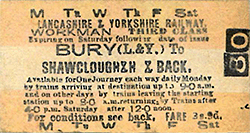 Shawclough & Healey station possessed a single platform, on the down side. The single-storey stone building was similar to that at Whitworth, though a little shorter. It was an unpretentious stone-built structure under a pitched roof, with plain rectangular openings. Midway along the platform elevation, flanked by office and waiting facilities, was a recessed open-fronted area in which passengers could shelter. Staff accommodation was provided in some cottages which already stood close to the station. A Yardley signal box stood on the platform west of the station building; it is not known how many levers were installed. The box closed in 1899 and two ground frames (Shawclough North and South) replaced it. Shawclough & Healey station possessed a single platform, on the down side. The single-storey stone building was similar to that at Whitworth, though a little shorter. It was an unpretentious stone-built structure under a pitched roof, with plain rectangular openings. Midway along the platform elevation, flanked by office and waiting facilities, was a recessed open-fronted area in which passengers could shelter. Staff accommodation was provided in some cottages which already stood close to the station. A Yardley signal box stood on the platform west of the station building; it is not known how many levers were installed. The box closed in 1899 and two ground frames (Shawclough North and South) replaced it.
The goods yard was on the opposite side of the running line from the passenger platform, where there were three loop lines, the outer one passing through the stone-built goods warehouse. Another siding was found behind the north end of the platform, and from this another siding diverged to serve Turner Bros’ (later Turner & Newall) Harridge Mill asbestos works. The siding was opened under an Agreement of 17 November 1919, and for many years a private locomotive was kept busy here. Turner’s were reputed at one time to operate the world’s largest asbestos factory on this and an adjoining site.
Up trains: weekdays
August 1887 |
Destination |
Down trains: weekdays |
Destination |
7.38am |
Rochdale |
7.13am |
Bacup |
8.40am |
Rochdale |
8.13am |
Bacup |
10.05am |
Rochdale |
9.41am |
Bacup |
10.58am |
Rochdale |
11.28am |
Bacup |
12.42pm |
Rochdale |
1.13pm |
Bacup |
3.05pm |
Rochdale |
2.40pm |
Bacup |
5.15pm |
Rochdale |
4.18pm |
Bacup |
6.05pm |
Rochdale |
5.38pm |
Bacup |
7.00pm |
Rochdale |
6.33pm |
Bacup |
8.00pm |
Rochdale |
8.08pm |
Bacup |
9.45pm |
Rochdale |
9.20pm Sat only |
Bacup |
10.58pm Sat only |
Rochdale |
10.20pm |
Bacup |
- |
- |
11.46pm Sat only |
Bacup |
Up trains: Sunday |
Destination |
Down trains: Sunday |
Destination |
8.32am |
Rochdale |
9.03am |
Bacup |
2.49pm |
Rochdale |
3.44pm |
Bacup |
7.27pm |
Rochdale |
8.07pm |
Bacup |
9.26pm |
Rochdale |
9.59pm |
Bacup |
On 13 May 1899 Shawclough was the scene of a fatal accident when two intending passengers, approaching the station from the goods yard, were mown down by the 10.38pm departure for Bacup.
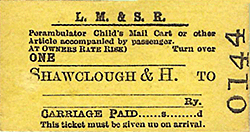 This station was some distance from the Rochdale-Bacup road, where competing public transport was available, but in the early twentieth century its environs were still distinctly rural and it closed to passengers on 2 April 1917 as a ‘wartime economy’; Britannia also closed on this date. However after hostilities Shawclough reopened. For many years, on Saturdays during the winter half of the year, crowded trains conveyed supporters of Rochdale AFC to and from Shawclough & Healey station which was the closest station to their Spotland ground. This station was some distance from the Rochdale-Bacup road, where competing public transport was available, but in the early twentieth century its environs were still distinctly rural and it closed to passengers on 2 April 1917 as a ‘wartime economy’; Britannia also closed on this date. However after hostilities Shawclough reopened. For many years, on Saturdays during the winter half of the year, crowded trains conveyed supporters of Rochdale AFC to and from Shawclough & Healey station which was the closest station to their Spotland ground.
Up trains: weekdays
July 1922 |
Destination |
Down trains: weekdays |
Destination |
7.02am |
Rochdale |
7.13am |
Bacup |
7.36am |
Rochdale |
9.31am |
Bacup |
8.25am |
Rochdale |
10.46am |
Bacup |
9.55am |
Rochdale |
12.03pm |
Bacup |
11.40am |
Rochdale |
1.33pm |
Bacup |
1.08pm |
Rochdale |
4.28pm |
Bacup |
2.25pm |
Rochdale |
5.46pm |
Bacup |
4.00pm |
Rochdale |
6.53pm |
Bacup |
6.10pm |
Rochdale |
8.23pm |
Bacup |
8.02pm |
Rochdale |
9.21pm |
Bacup |
10.13pm |
Rochdale |
10.42pm |
Bacup |
No Sunday trains |
- |
- |
- |
During World War 2 the services between Rochdale and Bacup remained fairly frequent although at irregular intervals: a feature of the timetable since the early days of the line. In July 1943 trains left Rochdale for Bacup at the following times: 7.00 and 9.25am; 12.05pm, 1.25, 4.20, 6.30 (Saturday excepted [SX]), 6.45 (Saturday only [SO]), 8.17 and 10.40 (SO). All trains called at Shawclough & Healey. Trains departed from Bacup for Rochdale at 6.41, 7.17, 8.07 and 9.37am; 12.48 (SO), 1.30, 2.07, 3.13 (SO), 4.45 (SO), 5.12 (SX), 5.52, 6.25 (SO) and 7.44. No passenger trains ran on Sunday.
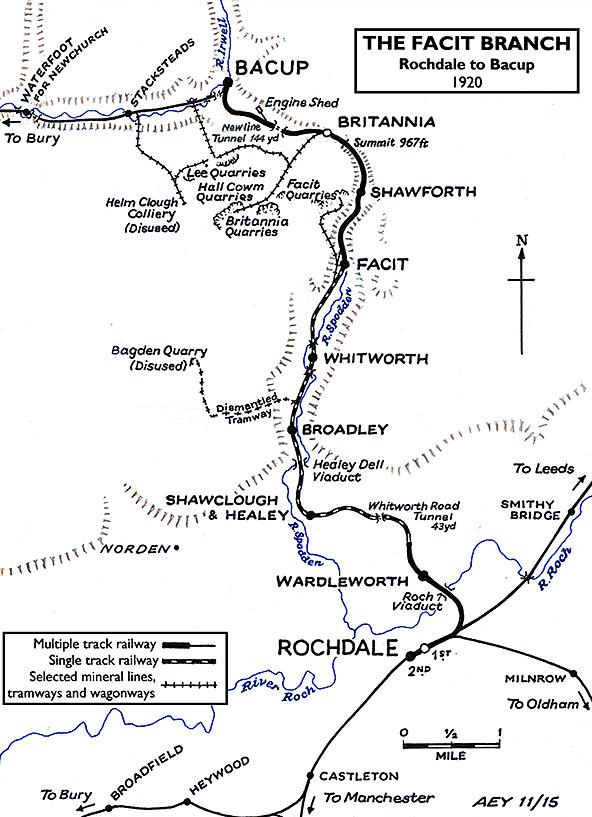
After the war, during which this and many other lines suffered reductions in train frequency, the service improved, as shown in the table below for 7 October 1946 to 4 May 1947:
Up trains: weekdays
October 1946 |
Destination |
Down trains: weekdays |
Destination |
7.03am |
Rochdale |
7.13am |
Bacup |
7.36am |
Rochdale |
9.34am |
Bacup |
8.26am |
Rochdale |
12.09pm |
Bacup |
9.56am |
Rochdale |
12.46pm (Sat only) |
Bacup |
12.29pm (Sat only) |
Rochdale |
1.35pm |
Bacup |
1.07pm |
Rochdale |
3.12pm |
Bacup |
1.59pm (Sat only) |
Rochdale |
4.30pm |
Bacup |
2.26pm |
Rochdale |
5.47pm (Sat only) |
Bacup |
3.56pm (Sat excepted) |
Rochdale |
5.49pm (Sat excepted) |
Bacup |
4.06pm (Sat only) |
Rochdale |
6.39pm (Sat excepted) |
Bacup |
5.33pm |
Rochdale |
6.54pm (Sat only) |
Bacup |
6.11pm |
Rochdale |
8.24pm |
Bacup |
6.26pm (Sat only) |
Rochdale |
9.15pm |
Bacup |
8.03pm |
Rochdale |
10.49pm |
Bacup |
10.14pm |
Rochdale |
- |
- |
No Sunday trains |
|
No Sunday trains |
|
Owing to competition from road transport, passenger services on the Rochdale-Bacup branch were withdrawn by the LMS on 16 June 1947. The closure was stated to be a temporary measure owing to a coal-supply crisis, but in December 1949 British Railways’ London Midland Region announced that the service would not be resumed. Apart from Britannia (closed in 1917) all of the intermediate stations survived until the closure of the line. Goods traffic continued to be handled at Shawclough until 6 January 1964, and probably because of the importance of the nearby asbestos factory’s traffic the stationmaster / goods agent who was also in charge of Facit and Whitworth stations’ goods traffic was based at Shawclough.
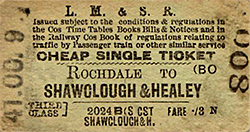 The stationmaster for much of the period when Shawclough dealt only with goods traffic was J J (Joe) Bramhill. He took on this role sometime after the end of passenger services on the line, having been stationmaster at Facit until then. Although based at Shawclough his responsibilities stretched from Wardleworth signal box to the end of the line at Facit, also including Whitworth station; Broadley closed to all traffic in 1952. Mr Bramhill continued to live in the LMS-built station house at Facit. Because there was no longer a passenger service, he travelled to work at Shawclough courtesy of Rochdale Corporation buses: route 16 from Facit to Healey Corner and route 2 from there to Shawclough. When Mr Bramhill retired in 1960 to Gainsborough in his native Lincolnshire, Alwyn Smith, relief stationmaster at Rochdale, temporarily filled the post until George Knights was promoted from booking clerk at Bacup to the stationmaster’s role at Shawclough. Staff who were supervised by the stationmaster were Ernie Woodhead (goods porter at Shawclough), Charlie Kidger (who had the same role at Whitworth) and Wardleworth signalman Albert Eastwood. Facit station closed to all traffic in August 1963 and thereafter Whitworth was the northern terminus of the goods line. The stationmaster for much of the period when Shawclough dealt only with goods traffic was J J (Joe) Bramhill. He took on this role sometime after the end of passenger services on the line, having been stationmaster at Facit until then. Although based at Shawclough his responsibilities stretched from Wardleworth signal box to the end of the line at Facit, also including Whitworth station; Broadley closed to all traffic in 1952. Mr Bramhill continued to live in the LMS-built station house at Facit. Because there was no longer a passenger service, he travelled to work at Shawclough courtesy of Rochdale Corporation buses: route 16 from Facit to Healey Corner and route 2 from there to Shawclough. When Mr Bramhill retired in 1960 to Gainsborough in his native Lincolnshire, Alwyn Smith, relief stationmaster at Rochdale, temporarily filled the post until George Knights was promoted from booking clerk at Bacup to the stationmaster’s role at Shawclough. Staff who were supervised by the stationmaster were Ernie Woodhead (goods porter at Shawclough), Charlie Kidger (who had the same role at Whitworth) and Wardleworth signalman Albert Eastwood. Facit station closed to all traffic in August 1963 and thereafter Whitworth was the northern terminus of the goods line.
On 6 January 1964 Shawclough & Healey closed to goods traffic leaving only Wardleworth and Whitworth handling goods. Wardleworth closed in November 1966 and Whitworth’s traffic survived until the line closed entirely in August 1967.
By the 1980s the suburbs of Rochdale were pushing northwards into the vicinity of the station, and the site of Shawclough & Healey station has been lost to housing development. However the station cottages, which pre-date the station, have survived and are in residential use. The railway embankment south of the station site is still in place beside the cottages and is now densely wooded, but the bridge over Dell Road has been removed. The Harridge Mill asbestos factory has long been closed and the site is covered by woodland. A recreational path now follows the railway route northwards across Healey Dell Viaduct to Broadley and beyond.
Route map drawn by Alan Young. Tickets from Michael Stewart.
Click here for a brief history and bibliography of the Bacup to Rochdale line.
To see other stations on the Bacup - Rochdale line click on
the station name:
Bacup, Britannia, Shawforth, Facit, Whitworth, Broadley, Wardleworth & Rochdale 1st Station
See also special feature: Facit branch viaducts and the Siamese bridges |
Shawclough & Healey Station Gallery 1:
6 November 1960 - 21 July 1962
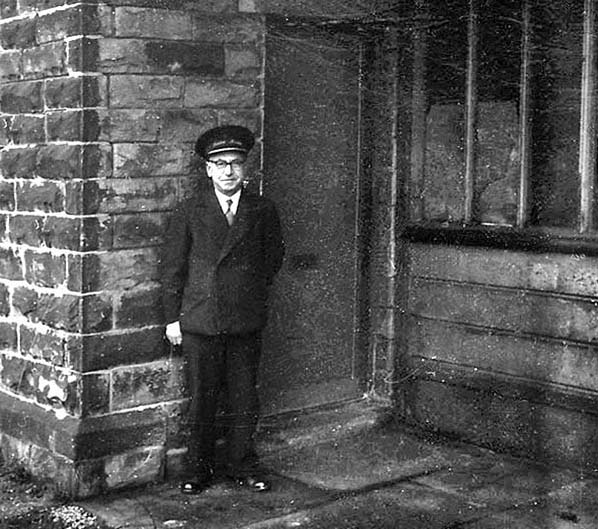 Until 1960 J J (Joe) Bramhill was stationmaster / goods agent of Facit, Whitworth and Shawclough & Healey stations during the time when the Facit Branch had a goods-only service; Wardleworth was probably supervised by Rochdale station. This photograph was taken at Shawclough outside the goods office door (the former booking office) on 6 November 1960 to mark his retirement – after which he was off to Hunt’s Bank to get his gold watch, and he retired to Gainsborough in his native Lincolnshire. Mr Bramhill was based at Shawclough & Healey station, presumably because there was a large amount of raw asbestos traffic from Salford Docks to the Turner Brothers Asbestos private siding there, as well as coal traffic for Samuel Heap's dyeworks at Spotland. He lived in the station house at Facit, built by the LMS on the site of Facit Station signal cabin; before the passenger service was withdrawn he had been stationmaster at Facit. He was assisted at Shawclough by an elderly goods clerk.
Photo by Eric Bollington

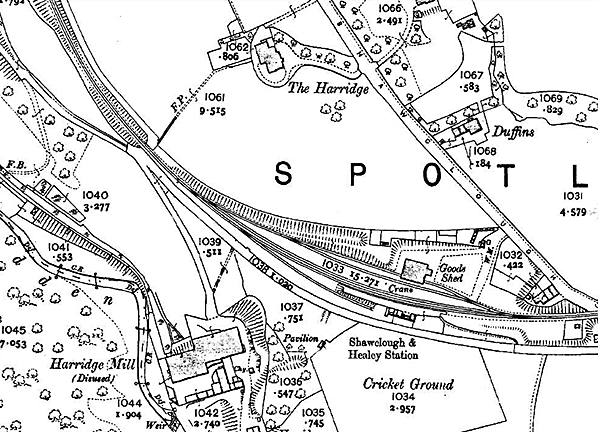
1910 1: 2,500 OS map. The platform of Shawclough & Healey station is south of the running line (on the down side). The station building on this platform is shown with its internal divisions, and immediately west is the signal box, which also stands on the platform. Shawclough & Healey station signal box, which was on the platform just west of the building (and shown on an 1893 OS map) closed in 1899 and has been removed. The neighbouring Harridge woollen mill has closed. Three loop lines face the platform, one of them passing though the goods warehouse. A crane is shown, as is a weigh office (WM=weighing machine) at the north-east corner of the goods yard. A siding extends behind the western half of the platform. The station cottages are marked, but not named, on a short cul-de-sac off Shawclough Road, east of the station. These are older than the station and are shown on the 1851 map as ‘Swinerootings’. West of the station is Harridge Mill, notable as a woollen mill in a county where the cotton industry was dominant. A cricket ground occupies the field directly south of the station. Presumably visiting cricket teams use the station, and another sporting association is with Rochdale Football Club whose ground is within easy walking distance; Shawclough & Healey station is a busy place on winter Saturday afternoons Click here for a larger version.
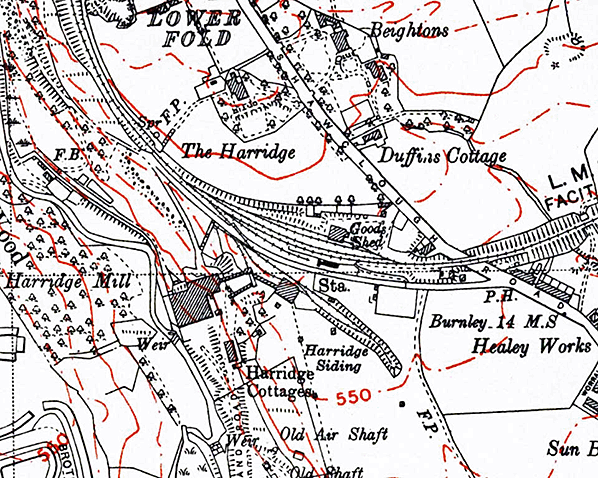
1938 1: 10,560 OS map. A significant industrial development has taken place close to the station. Following an Agreement of November 1919 rail access has been provided to Turner Bros’ asbestos works in the former Harridge woollen mill. The new ‘Harridge Siding’ includes two loops and a headshunt, occupying the site of the cricket ground, and two sidings have been added, entered from the north. A conveyor (not labelled) is shown from the sidings to the factory. The cricketers have been ousted, but there is now a tennis ground immediately south-east of the station; its outline is shown, but it is not named. An engineering works, also to the south-east, has opened within easy reach of the station. Terraced housing has advanced from the south-east towards the station, but to the north the area retains its semi-rural character, with some large houses shown within extensive gardens.
1959 1: 2,500 OS map. Although it handles only goods traffic now, the station is still named. The loops, sidings and goods warehouse are still in place. Illustrating OS policy of giving ‘security treatment’ to industrial premises in the Cold War era, the asbestos factory is now just ‘Works’. The factory continued to make use of the railway, being one of its primary customers until the line closed to all traffic in August 1967.The station cottages are now shown as nos.2, 4 and 6 Harridge Bank.
Click here for a larger version.
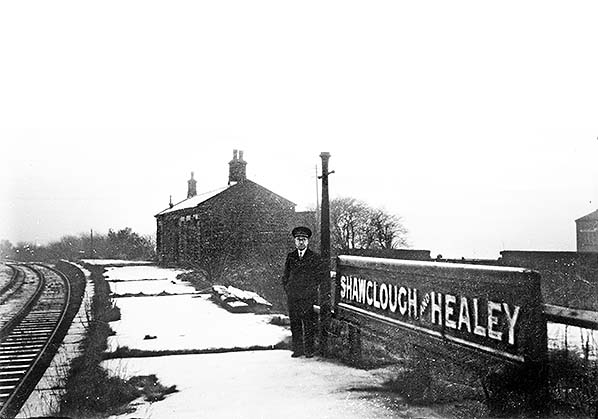
This photograph of J J (Joe) Bramhill at Shawclough & Healey was probably taken on the same occasion as the picture of him standing by the goods office door: 6 November 1960, on his retirement as stationmaster / goods agent. Although the station closed to passengers in 1947 the booking office in the station building, seen in the background, continued to be used as the goods office. The fine nameboard will be noted, with the interesting angle of the word ‘and’. Mr Bramhill was stationmaster at Facit until the passenger trains were withdrawn, after which he was based at Shawclough & Healey as stationmaster and goods agent, but in this capacity he also supervised Whitworth and Facit stations.
Photo by Eric Bollington
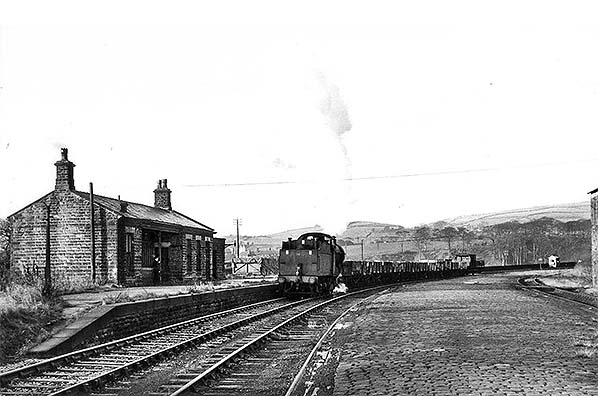
Shawclough & Healey station looking west on 10 December 1960. At this time the station is closed to passengers, but the office in the station building is used by the stationmaster/goods agent and goods traffic is still handled in the sidings. The ‘main line’ adjoins the platform, and is being used by Fowler-designed Class 4F 0-6-0 No.44096 which is returning empty wagons from Turner’s Asbestos (Harridge) siding. The track to its right is one of the station’s three loops. The goods warehouse is out of view on the right. The loco was built for the LMS by Kerr Stewart of Stoke-on-Trent in November 1925 and allocated the number 4096. In BR ownership ‘4’ was prefixed to the number. On 30 September 1964 she was withdrawn from 39A, Gorton shed, and disposed of at Cohens Ickles scrapyard, Rotherham, in February 1965.
Photo
by Ian G Holt
Looking north-east at Shawclough & Healey station on 10 December 1960. The loco, Fowler 4F 0-6-0 No.44096, has been returning empty wagons from Turner’s Asbestos (Harridge) siding. The track to its right is one of the station’s three loops. The goods warehouse is out of view on the right. The ground frame to control access to the north end of the yard is in the distant timber cabin. The loco was built for the LMS by Kerr Stewart of Stoke-on-Trent in November 1925 and allocated the number 4096. In BR ownership ‘4’ was prefixed to the number. On 30 September 1964 she was withdrawn from 39A, Gorton shed, and disposed of at Cohens Ickles scrapyard, Rotherham, in February 1965.
Photo
by Ian G Holt

On 10 December 1960 Fowler 4F 0-6-0 No.44096 is seen north-west of Shawclough & Healey station. Turner’s Asbestos works is in the background. The loco returned empty wagons to the works’ siding on this occasion. The loco was built for the LMS by Kerr Stewart of Stoke-on-Trent in November 1925 and allocated the number 4096. In BR ownership ‘4’ was prefixed to the number. On 30 September 1964 she was withdrawn from 39A, Gorton shed, and disposed of at Cohens Ickles scrapyard, Rotherham, in February 1965.
Photo
by Ian G Holt
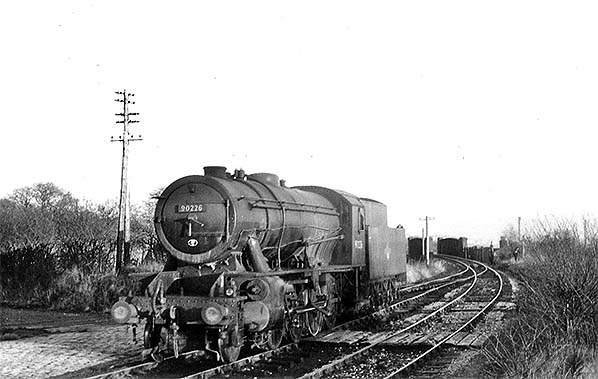
Looking east from the end of the platform at Shawclough & Healey on 10 January 1961. The main line is on the right, while No.90226 is on one of the station’s loops. The parapets of the bridge over Dell Road are seen beyond the junction. The loco is a Riddles-designed War Department 2-8-0 built c1943. She was withdrawn in December 1963 from 26D, Bury shed, and cut up in February 1964 at BR Crewe works.
Photo
by Ian G Holt
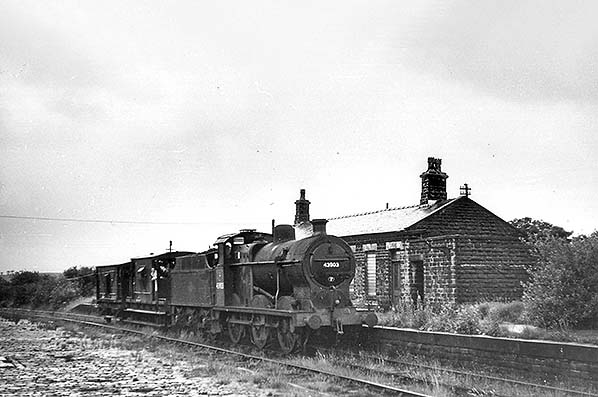 On 21 July 1962, a week before the ‘Salford Hundred Rail Tour’ visited the Facit Branch, No.43909 stands with the Saturday goods train at Shawclough & Healey station. The passenger platform has been colonised by weeds following the withdrawal of passenger services in 1947 but the goods yard remains open and the station building is used by the stationmaster/goods agent who also supervises Whitworth and Facit stations. The loco was built in April 1920 at the Midland Railway’s Derby works. She was withdrawn from 16C, Kirkby-in-Ashfield shed, on 9 May 1964 and cut up in December 1964 by the Slag Reduction Co Ltd, Ickles, Rotherham.
On 21 July 1962, a week before the ‘Salford Hundred Rail Tour’ visited the Facit Branch, No.43909 stands with the Saturday goods train at Shawclough & Healey station. The passenger platform has been colonised by weeds following the withdrawal of passenger services in 1947 but the goods yard remains open and the station building is used by the stationmaster/goods agent who also supervises Whitworth and Facit stations. The loco was built in April 1920 at the Midland Railway’s Derby works. She was withdrawn from 16C, Kirkby-in-Ashfield shed, on 9 May 1964 and cut up in December 1964 by the Slag Reduction Co Ltd, Ickles, Rotherham.
Photo
by Ian G Holt
Click here for Shawclough & Healey Station Gallery 2:
21 July 1962 - February 2016
| Last
updated: Friday, 26-May-2017 10:55:32 CEST |
© 1998-2016 Disused Stations
| |





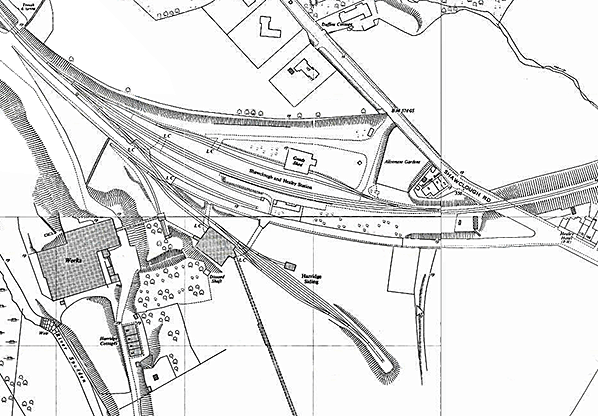






 Shawclough & Healey station possessed a single platform, on the down side. The single-storey stone building was similar to that at Whitworth, though a little shorter. It was an unpretentious stone-built structure under a pitched roof, with plain rectangular openings. Midway along the platform elevation, flanked by office and waiting facilities, was a recessed open-fronted area in which passengers could shelter. Staff accommodation was provided in some cottages which already stood close to the station. A Yardley signal box stood on the platform west of the station building; it is not known how many levers were installed. The box closed in 1899 and two ground frames (Shawclough North and South) replaced it.
Shawclough & Healey station possessed a single platform, on the down side. The single-storey stone building was similar to that at Whitworth, though a little shorter. It was an unpretentious stone-built structure under a pitched roof, with plain rectangular openings. Midway along the platform elevation, flanked by office and waiting facilities, was a recessed open-fronted area in which passengers could shelter. Staff accommodation was provided in some cottages which already stood close to the station. A Yardley signal box stood on the platform west of the station building; it is not known how many levers were installed. The box closed in 1899 and two ground frames (Shawclough North and South) replaced it. This station was some distance from the Rochdale-Bacup road, where competing public transport was available, but in the early twentieth century its environs were still distinctly rural and it closed to passengers on 2 April 1917 as a ‘wartime economy’; Britannia also closed on this date. However after hostilities Shawclough reopened. For many years, on Saturdays during the winter half of the year, crowded trains conveyed supporters of Rochdale AFC to and from Shawclough & Healey station which was the closest station to their Spotland ground.
This station was some distance from the Rochdale-Bacup road, where competing public transport was available, but in the early twentieth century its environs were still distinctly rural and it closed to passengers on 2 April 1917 as a ‘wartime economy’; Britannia also closed on this date. However after hostilities Shawclough reopened. For many years, on Saturdays during the winter half of the year, crowded trains conveyed supporters of Rochdale AFC to and from Shawclough & Healey station which was the closest station to their Spotland ground. 
 The stationmaster for much of the period when Shawclough dealt only with goods traffic was J J (Joe) Bramhill. He took on this role sometime after the end of passenger services on the line, having been stationmaster at Facit until then. Although based at Shawclough his responsibilities stretched from Wardleworth signal box to the end of the line at Facit, also including Whitworth station; Broadley closed to all traffic in 1952. Mr Bramhill continued to live in the LMS-built station house at Facit. Because there was no longer a passenger service, he travelled to work at Shawclough courtesy of Rochdale Corporation buses: route 16 from Facit to Healey Corner and route 2 from there to Shawclough. When Mr Bramhill retired in 1960 to Gainsborough in his native Lincolnshire, Alwyn Smith, relief stationmaster at Rochdale, temporarily filled the post until George Knights was promoted from booking clerk at Bacup to the stationmaster’s role at Shawclough. Staff who were supervised by the stationmaster were Ernie Woodhead (goods porter at Shawclough), Charlie Kidger (who had the same role at Whitworth) and Wardleworth signalman Albert Eastwood. Facit station closed to all traffic in August 1963 and thereafter Whitworth was the northern terminus of the goods line.
The stationmaster for much of the period when Shawclough dealt only with goods traffic was J J (Joe) Bramhill. He took on this role sometime after the end of passenger services on the line, having been stationmaster at Facit until then. Although based at Shawclough his responsibilities stretched from Wardleworth signal box to the end of the line at Facit, also including Whitworth station; Broadley closed to all traffic in 1952. Mr Bramhill continued to live in the LMS-built station house at Facit. Because there was no longer a passenger service, he travelled to work at Shawclough courtesy of Rochdale Corporation buses: route 16 from Facit to Healey Corner and route 2 from there to Shawclough. When Mr Bramhill retired in 1960 to Gainsborough in his native Lincolnshire, Alwyn Smith, relief stationmaster at Rochdale, temporarily filled the post until George Knights was promoted from booking clerk at Bacup to the stationmaster’s role at Shawclough. Staff who were supervised by the stationmaster were Ernie Woodhead (goods porter at Shawclough), Charlie Kidger (who had the same role at Whitworth) and Wardleworth signalman Albert Eastwood. Facit station closed to all traffic in August 1963 and thereafter Whitworth was the northern terminus of the goods line. Home Page
Home Page